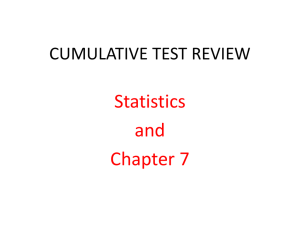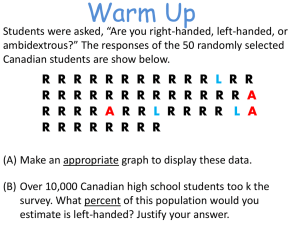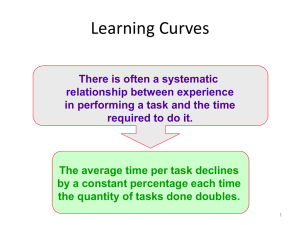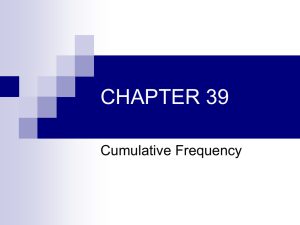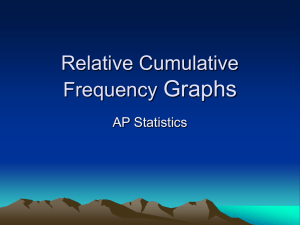Cumulative Frequency
advertisement
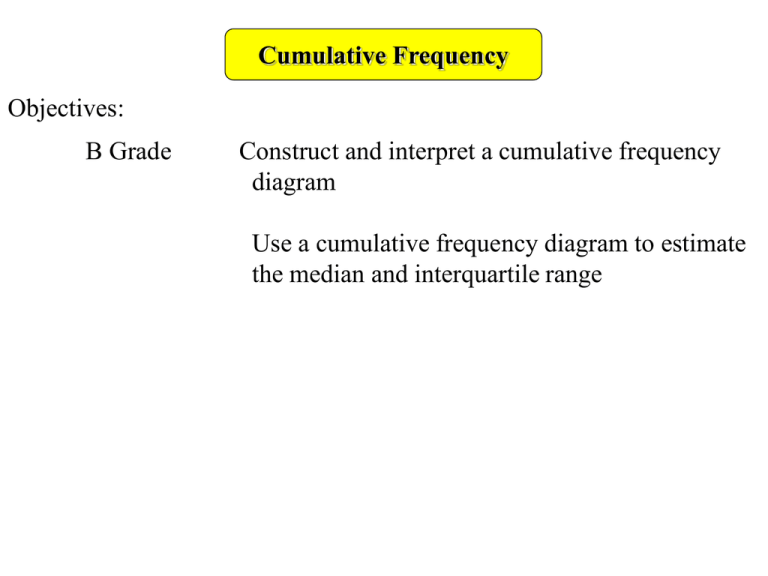
Cumulative Frequency Objectives: B Grade Construct and interpret a cumulative frequency diagram Use a cumulative frequency diagram to estimate the median and interquartile range Cumulative Frequency A cumulative frequency diagram is a graph that can be used to find estimates of the median and upper and lower quartiles of grouped data. The median is the middle value when the data has been placed in order of size The lower quartile is the ‘median’ of the bottom half of the data set and represents the value ¼ of the way through the data. The upper quartile is the ‘median’ of the top half of the data set and represents the value ¾ of the way through the data. Cumulative Frequency A pet shop owner weighs his mice every week to check their health. The weights of the 80 mice are shown below: weight (g) 0 < w ≤ 10 10 < w ≤ 20 20 < w ≤ 30 30 < w ≤ 40 40 < w ≤ 50 50 < w ≤ 60 60 < w ≤ 70 70 < w ≤ 80 80 < w ≤ 90 90 < w ≤100 Frequency Cumulative (f) Frequency 3 3 5 8 5 13 22 9 33 11 15 48 62 14 8 70 76 6 80 4 Cumulative means adding up, so a cumulative frequency diagram requires a running total of the frequency. Cumulative Frequency 0 < w ≤ 10 10 < w ≤ 20 20 < w ≤ 30 30 < w ≤ 40 40 < w ≤ 50 50 < w ≤ 60 60 < w ≤ 70 70 < w ≤ 80 80 < w ≤ 90 90 < w ≤100 Frequency Cumulative (f) Frequency 3 3 5 8 5 13 22 9 33 11 15 48 62 14 8 70 76 6 80 4 x x x 70 Cumulative frequency Weight (g) 80 x 60 50 x 40 x 30 x 20 x 10 0 x x 0 10 20 30 40 50 60 Weight (g) 70 80 90 The point are now joined with lines cumulative frequency (c.f.)straight can now be plotted on a graph The line always at the taking care to plotstarts the c.f. at the end of each class interval. bottom of the first class interval This is because we don’t know in the interval called an The resulting graph should lookwhere like this andclass is sometimes 0‘S’ < curve. w ≤ 10, the values are, but we do know that by the end of the class interval there are 3 pieces of data 100 Cumulative Frequency x x Cumulative frequency From this graph we can now find estimates of the median, and upper and lower quartiles Upper quartile There are 80 pieces of data 80 The lower is the 20th x 70 middlequartile is the 40th x piece of data ¼ of the total 60 pieces of data 50 x th The upper quartile is the 60 Median position 40 piece of data ¾ of the total x Read across, then 30 pieces of data Down find the x 20 Lowertoquartile median weight x 10 x 0 Lower quartile is 38g Median weight is 54g Upper quartile is 68g x 0 10 20 30 40 50 60 Weight (g) 70 80 90 100 Cumulative Frequency The upper and lower quartiles can now be used to find what is called The interquartile range and is found by: Upper quartile – Lower quartile In this example: Lower quartile is 38g Upper quartile is 68g The interquartile range (IQR) = 68 – 38 = 30g Because this has been found by the top ¾ subtract the bottom ¼ ½ of the data (50%) is contained within these values So we can also say from this that half the mice weigh between 38g and 68g Cumulative Frequency In an international competition 60 children from Britain and France Did the same Maths test. The results are in the table below: Marks 1-5 6 - 10 11 - 15 16 - 20 21 - 25 26 - 30 31 - 35 Britain Frequency 1 2 4 8 16 19 10 Britain c.f. France Frequency 2 5 11 16 10 8 8 France c.f Using the same axes draw the cumulative frequency diagram for each country. Find the median mark and the upper and lower quartiles for both countries and the interquartile range. Make a short comment comparing the two countries Cumulative Frequency Marks 1-5 6 - 10 11 - 15 16 - 20 21 - 25 26 - 30 31 - 35 Britain Frequency 1 2 4 8 16 19 10 Britain c.f. 1 3 7 15 31 50 60 Britain France Frequency 2 5 11 16 10 8 8 Both have 60 pieces of data France c.f 2 7 18 34 44 52 60 Median position is 30 Lower quartile position is 15 Upper quartile position is 45 x 60 Britain LQ = 20 Median = 25 UQ = 29 IQR = 9 Cumulative frequency France xx 50 x France x LQ = 13.5 Median = 19 UQ = 26 IQR = 12.5 40 x 30 20 x 10 0 0 xx 5 x x 10 x x 15 20 Marks 25 30 35 The scores in Britain are higher with less variation Cumulative Frequency Summary B Grade Construct and interpret a cumulative frequency diagram Use a cumulative frequency diagram to estimate the median and interquartile range • • • • • • Make a running total of the frequency Put the end points not the class interval on the x axis Plot the points at the end of the class interval Join the points with straight lines – if it is not an ‘S’ curve ****Check your graph**** Find the median by drawing across from the middle of the cumulative frequency axis Find the LQ and UQ from ¼ and ¾ up the c.f. axis
